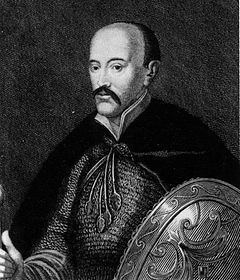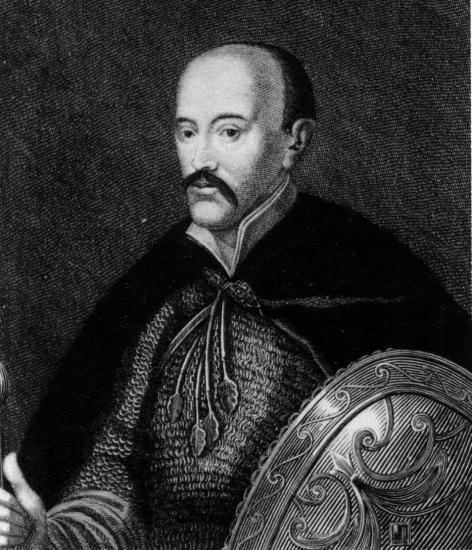Wife Ewa Pac Name Aleksander Gosiewski | Father John Korwin Gosiewski Family Gosiewski | |
 | ||
Died April 1639, Vilnius, Lithuania Children Wincenty Korwin Gosiewski, Krzysztof Korwin Gosiewski, Zuzanna Korwin Gosiewska Grandchildren Boguslaw Korwin Gosiewski, Teresa Korwin Gosiewska People also search for Wincenty Korwin Gosiewski | ||
Aleksander Korwin Gosiewski (Lithuanian: Aleksandras Korvinas Gosievskis) de armis Ślepowron (b. – d. 1639), was a Polish nobleman, military commander and diplomat, Lithuanian Field-Quartermaster since 1630, Palatine-Governor of Smolensk from 1625, Lithuanian Great-Quartermaster since 1615, Speaker of the Parliament in 1613, Great-Secretary of the Grand Duchy of Lithuania from 1610 and District-Governor of Wieliż, Puńsk, Kupise, Biel, and Markowa.
Contents

Youth
He came from the noble family Gosiewski of Zambrowski county in the land of Łomża, a family entitled to use the coat of arms Ślepowron. He lived in the first half of the 16th century, son of John Gosiewski who was married to Ewa (née Pac, the Chamberlain of Brest’s daughter).
Already in his youth, as Lew Sapieha’s courtier, was involved in the affairs of the state. In 1600, as member of Lew Sapieha’s retinue, he played a significant role in the negotiations with Moscovia, editing the planned alliance acts between Poland-Lithuania with the Muscovite state. In 1602, even as District-Governor of Wieliż, attended the drawing of the border between Poland-Lithuania and Moscovia – he became famous repelling a Russian troops attack on his own district. Then, during the wars of Sigismund III Vasa against his uncle Charles, the usurper King of Sweden, he served in the Lithuanian army. In 1605, he fought in the Battle of Kircholm. In 1606, as a member of the retinue of Mikołaj Oleśnicki, he escorted Maryna Mniszchówna to Moscow, where he led negotiations for an alliance with Tsar Dmitri.
Military career
He was an ardent supporter of Polish military intervention in Moscow during the time of Troubles. In July 1609, he conducted his own expedition to Wielkie Łuki. Then he became famous for planting firecrackers to the walls of the fortress during the siege of Smolensk. In 1610 at the head of a sizeable branch of the military operation conducted independently in the north of Smolensk, which was to get Bely fortress. Subsequently, he reached Moscow, which, after the battle of Klushino was taking by Great-Commander Stanisław Żółkiewski de armis Lubicz. In 1610, he was appointing by Commander Żółkiewski to lead the Polish army commander of the Moscow Kremlin. In 1611 the Russians betrayal their old Polish patrons, at the head of a branch off insurrected led to the great fire of Moscow. In the year 1612 over the command of the Polish garrison Mikołaj Struś de armis Korczak and returned to Lithuania. Residents of the city under the leadership of a merchant Kuzma Minin and Prince Dmitry Pozharsky began to lock the Kremlin. The commander of the Polish garrison in the Kremlin, Mikołaj Struś, deprived of relief from the Polish king Sigismund III Vasa, surrendered on 4 November 1612. To commemorate the event tsar Mikhail Romanov instituted a holiday named Day of Moscow’s Liberation from Polish Invaders in 1613, in 2004 the public holiday became the Unity Day, which was first celebrated in 2005.
In 1612, the Polish garrison commander at Smolensk fending off all these years numerous attacks of the Russian troops. In 1615, as Lithuanian Field-Quartermaster, he led a small army to block the insurrected Russian army. In 1617 and 1618, Polish Lithuanian troops participated in a failed expedition to Moscow led by Prince Wladyslaw. In 1618, he commanded the garrison during the siege of Smolensk. After the arriving of the king’s troops he camped together with the Commander Jan Karol Chodkiewicz’ troops besieging the city (Chodkiewicz de armis Kościesza.
Politics
He was the Speaker of the Parliament extraordinary held in Warsaw on 3 December to 24 December 1613. During the war with Sweden (1621–1625 war) and the (war 1626–1629) fought in Livonia winning to the Swedish army at Kroppenhof, Lixna, Slavskoye and Dyneburg. It is because of fighting with the Swedes until 1629, he was appointing Palatine-Governor of Smolensk region, but the nomination was already in 1625. Seeing the threat from Russia, Gosiewski immediately upon taking the governorate of Smolensk began to renovate the walls of the city. He personally oversaw the construction of Sigismund Fortress, which strengthened the eastern part of the stronghold. Intensively collected supplies of food and ammunition, and developed a business intelligence gathering valuable information about Moscow's war preparations. In the spring of 1632, he made review the fortifications in Dorogobuzh and other frontier forts.
During the war with Russia, in the year 1632 and 1634 after a particularly famous defense of Smolensk – for ten months he defended the city against besieging forces led by Mikhail Shein, repelling all assaults, until the advent of the battle led by Prince Władysław. He fought at Vitebsk, Alder and Mstislav. He participated as a Commissioner in peace negotiations, topped the conclusion on 14 June 1634, in Treaty of Polanów.
For his services, he received numerous goods in the province of Smolensk. He founded the Jesuits’ College in Vitebsk and the female Monastery of the Holy Brigit at Brest-Litovsk. As Palatine-Governor, he commemorated the death of his longtime client – Jan Kunowski, who in 1640 wrote a series of poems dedicated to his late patron.
Death
He died in April 1639.
Family
Aleksander Korwin Gosiewski came from the Ślepowron branch of the family.
He was married to Ewa Pac. They had one daughter, Zuzanna, and two sons; Wincenty and Krzysztof.
